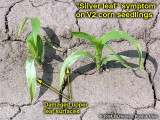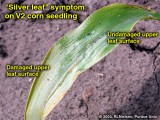

![]() arly
morning temperatures were quite chilly around parts of Indiana early last week.
Some areas of northern Indiana experienced frost and even near lethal (28F or
less) temperatures. Other areas reported temperatures in the mid to high 30's
with no frost. If you've been out walking your early-planted cornfields recently,
you may have noticed a curious leaf symptom that may remind you of freezer burn.
arly
morning temperatures were quite chilly around parts of Indiana early last week.
Some areas of northern Indiana experienced frost and even near lethal (28F or
less) temperatures. Other areas reported temperatures in the mid to high 30's
with no frost. If you've been out walking your early-planted cornfields recently,
you may have noticed a curious leaf symptom that may remind you of freezer burn.
Rapid heat loss from terrestrial surfaces to the atmosphere (i.e., radiational cooling) can occur on clear, dry (low humidity), calm nights with temperatures in the low 40's F or cooler. Minor levels of radiational cooling can damage the outer surfaces of corn leaves that are positioned horizontally or parallel to the night sky. The subsequent symptom of such minor chilling injury is often referred to as "silver leaf" in corn.
Click on image to open a larger version. |
|
 "Silver leaf" symptom on V2 corn seedlings
exposed to mid-30's (F) temperatures. "Silver leaf" symptom on V2 corn seedlings
exposed to mid-30's (F) temperatures. |
 Closeup of "silver leaf" symptom. Closeup of "silver leaf" symptom. |
The "silver leaf" symptom indeed appears as a silvery or dull gray leaf surface. Any portion of a leaf that was not horizontal to the sky or that was protected by another leaf or plant part will not exhibit the symptom.
The effect of this type of minor leaf damage is negligible, if any. The leaves will not die abruptly as will genuinely frosted leaf tissue. Continued expansion of the whorl will not be restricted in any way. New leaves that expand from the whorl will be normal in appearance. This symptom is more of a curiosity than a nuisance.